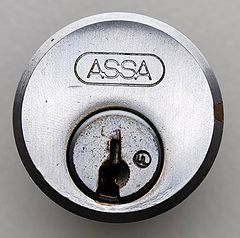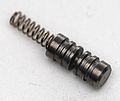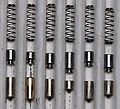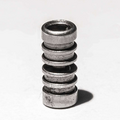ASSA Twin 6000
ASSA Twin 6000
| ASSA Twin 6000 | |
 | |
| Name | ASSA Twin 6000 |
|---|---|
| Manufacturer | ASSA |
| Lock Type | Cylinder |
| Lock Design | Pin-tumbler, Sidebar |
| Year(s) Produced | 1981-present[1] |
| Patent | US 4,393,673 (Bo Widen) |
| Specifications | |
| # of Components | 6 |
| Component Type | Pin-tumbler |
| Related Locks | |
| ASSA Twin V-10 ASSA Twin Combi ASSA Twin Exclusive ASSA Twin Maximum ASSA Twin Pro | |
The Twin (or Twin 6000) is a UL 437-rated pin-tumbler lock made by ASSA. The 6000 is part of the Twin series of locks that use pin-tumblers and a sidebar to provide two layers of security. The 6000 is the original Twin series model. Later systems made by ASSA built upon the 6000 to provide increased security against manipulation and key duplication. The ASSA Twin 6000 was patented in 1980 by inventor Bo G. Widen.[2]
The 6000 has since been superceded by other Twin series models, particularly the ASSA Twin V-10 and ASSA Twin Combi.
Principles of operation
|
|
ASSA literature numbers pins and key bitting positions from tip (back) to bow (front). Lockwiki uses the traditional terms and positions to avoid confusion. |
The 6000 uses six pin-tumbler pins and five sidebar side pins. To open the lock, all pin-tumblers must be aligned at the shear line and all side pins must be properly aligned with the sidebar legs. Balanced pin stacks are used to resist attack from comb picks as well as reduces wear on the springs. Driver pins come in four sizes and use a modified spool design which is combined with counter-milling in the plug chambers to provide high pick resistance. There are nine depths for pin-tumblers, allowing for 531,441 (96) theoretical key differs for the pin-tumbler portion of the lock. The MACS for this lock is five depths, giving the 6000 around 160,000 real key differs. Master keying is available using traditional pin-tumbler master pins available in eight sizes.
Unlike many other sidebar locks, the Twin 6000 side pins are identical. Cuts are made on the sidebar directly and side pins must be raised to match these positions. All side pins use serrations above and below the true gate to provide manipulation resistance. Rekeying of the sidebar portion of the lock is only possibly when the sidebar is physically replaced or flipped upside-down. This interaction between side pins and sidebar gates frustrates traditional decoding attacks that attempt to measure the range of movement of the side pins. There are five depths available for side pins, giving the Twin 3,125 theoretical sidebar differs (55). There are 2,800 real sidebar differs, using 1400 sidebars that can be flipped in either orientation. Keys blanks are stamped with a three digit indirect sidebar bitting code and sometimes an additional two digit keyway code.
To provide resistance against destructive entry, the 6000 uses hardened steel pins in the front of the plug and near the sidebar and third and fourth pin-stacks. In addition, driver pins are made of stainless steel to frustrate drilling of the pin stacks.
Notes
- The pin-tumbler bitting code is referred to as the system code, and the sidebar bitting code as the sidebar code.
- Security pin design is based on a 1942 patent by Ralph Paul Crousore.[3][4]
Disassembly instructions
The 6000 is disassembled in the same way as a traditional pin-tumbler cylinder. The sidebar does not cause too many problems when the plug is removed. When the key is removed from the exposed plug the side pins will be forced out by spring pressure. Plug diameter is 12.95mm.
- Remove the cam or C-clip.
- Insert the key and turn the plug 45-90 degrees.
- Withdraw the plug from the cylinder. (A plug follower is recommended)
OR
- Remove the chamber casings and take out each pin-stack individually
- Remove the cam or C-clip.
- Withdraw the plug from the cylinder.
Vulnerabilities
The 6000 system may be vulnerable to one or more of the following:
Notes
- Bumping is possible given a bump key with the correct sidebar bitting.
Gallery
References
- ↑ The History of ASSA High-Security Locks
- ↑ US #4,393,673A. Cylinder lock.
- ↑ US #2,283,489. Pin and Cylinder Lock.
- ↑ PULFORD, Graham (2007). High Security Mechanical Locks: An Encyclopedic Reference. ISBN 0750684372.







